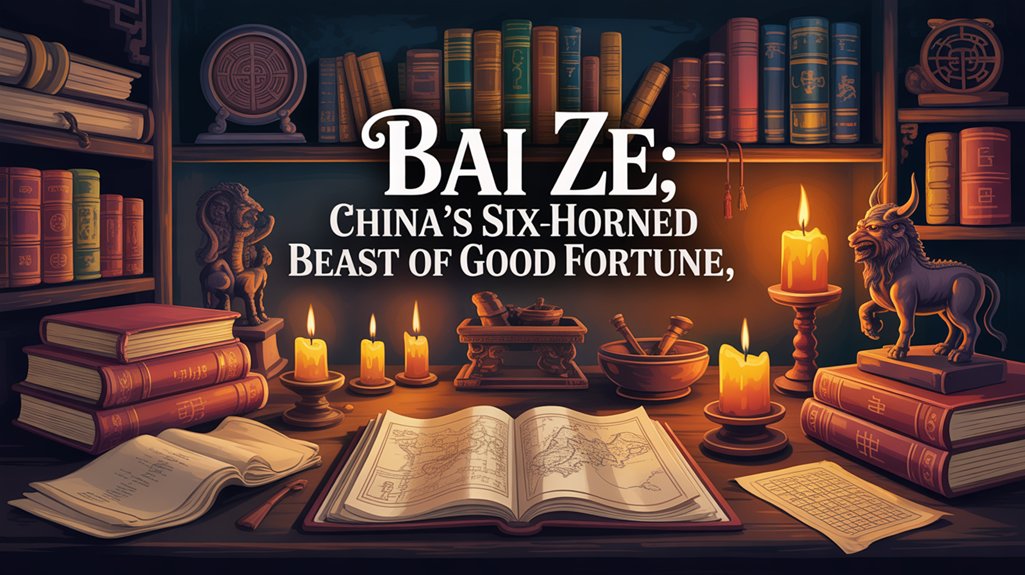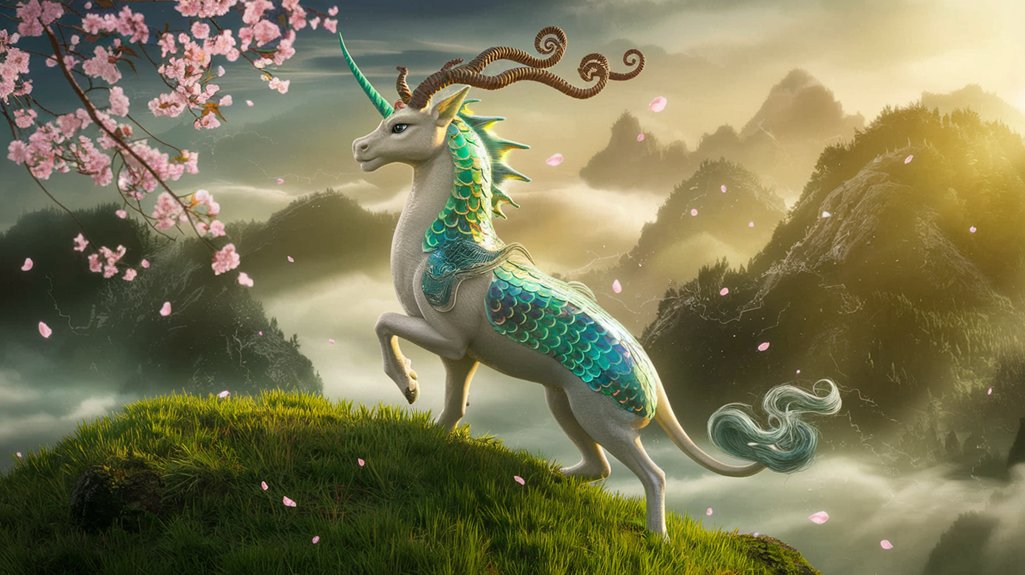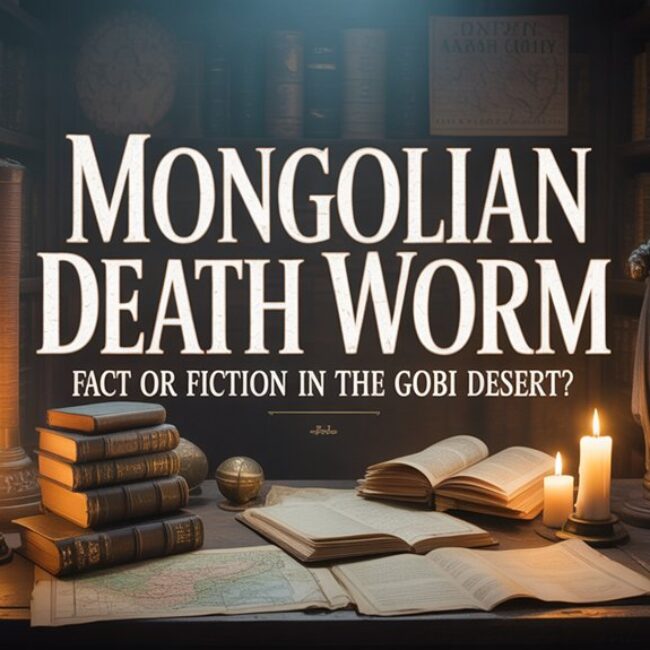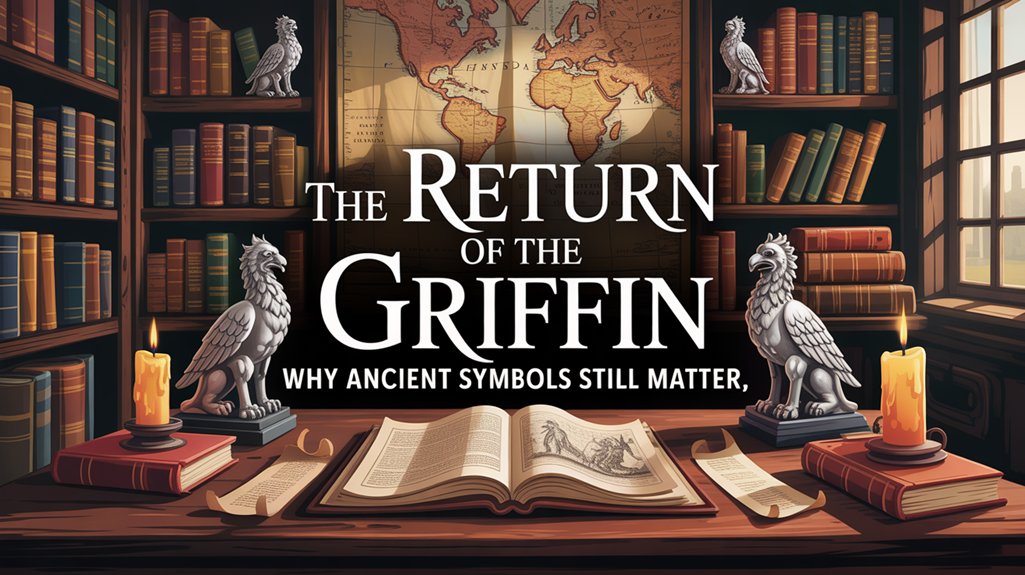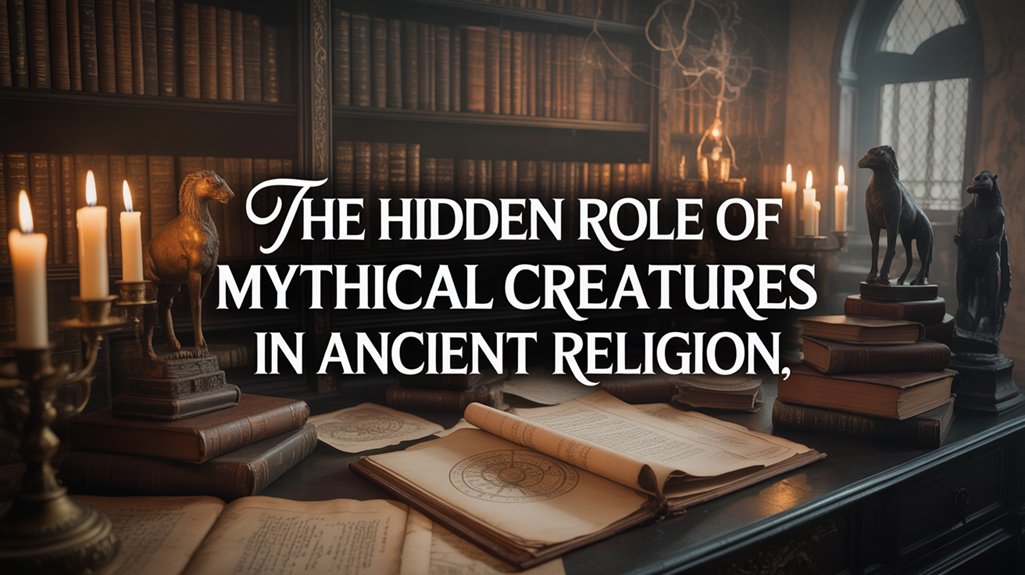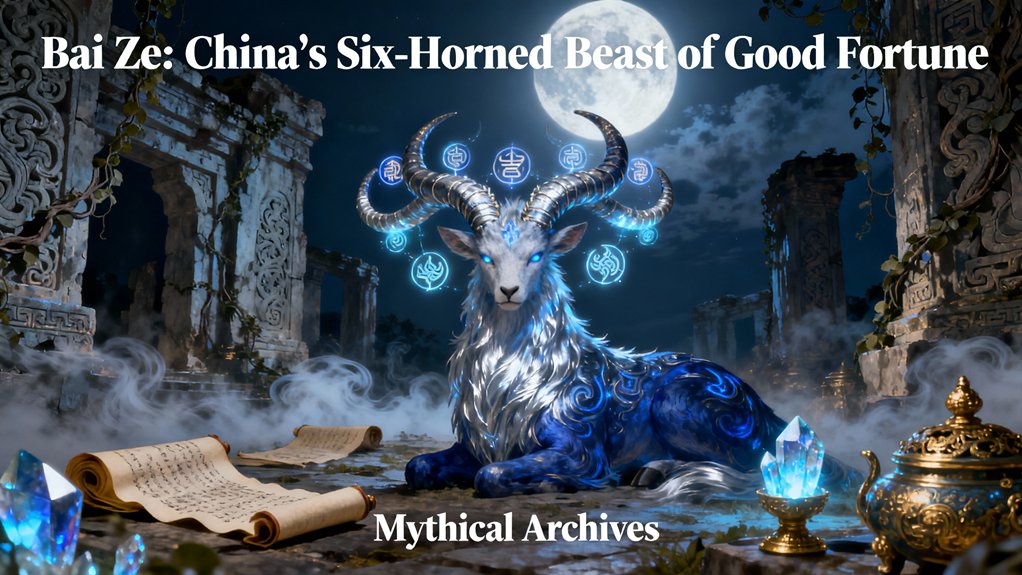
You’ll encounter Bai Ze as the six-horned chimeric beast who appeared before Yellow Emperor Huangdi atop Mount Huandou, its crystalline scales gleaming with omniscient knowledge of 11,520 eldritch entities inhabiting the liminal spaces between mortal and divine domains. This creature’s nine eyes perceived what remained hidden to ordinary sight, while its graduated horns symbolized mastery over heaven, earth, and underworld—altering chaotic spiritual phenomena into systematic demonology preserved within the *Baize Tu*. Its image became a protective talisman across East Asia, warding against supernatural afflictions through jade pendants and household scrolls that changed everyday objects into spiritual armaments against spectral maladies that threatened cosmic harmony—wisdom that continues resonating through contemporary culture’s reinterpretation of ancient protection.
Table of Contents
ToggleKey Takeaways
- Bai Ze is a chimeric creature with six horns symbolizing mastery over heaven, earth, and underworld realms.
- The beast met Yellow Emperor Huangdi and shared knowledge of 11,520 supernatural entities, creating China’s first systematic demonology.
- Its image serves as a powerful protective talisman against malevolent spirits, epidemics, and chaos throughout Chinese history.
- Bai Ze appears in Tang and Song Dynasty texts, influencing East Asian cultures including Korean and Japanese traditions.
- The creature remains culturally relevant today, appearing in anime, video games, and contemporary art as ancestral wisdom symbol.
The Legendary Encounter Between Bai Ze and the Yellow Emperor
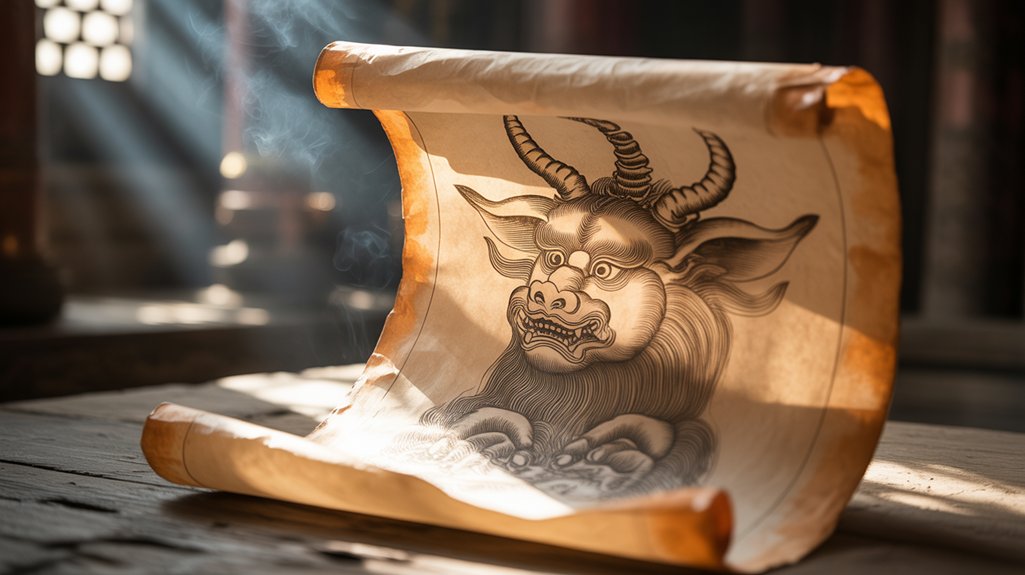
When the Yellow Emperor, Huangdi (traditionally dated to 2697-2597 BCE), traversed the windswept peaks of Mount Huandou during his campaign to unite the warring tribes of ancient China, he encountered a creature that would fundamentally change humanity’s understanding of the supernatural sphere.
This legendary encounter introduced Bai Ze, whose chimeric form bore six horns crowning its leonine head, each representing mastery over distinct categories of spiritual phenomena.
The beast spoke. Its voice carried knowledge of 11,520 eldritch entities inhabiting the liminal spaces between mortal and divine domains.
Between worlds, Bai Ze catalogued thousands of entities—each spirit, demon, and supernatural force systematically named and understood.
You’ll find this mythical significance extends beyond mere folklore—Bai Ze offered systematic classification of spirits, demons, and supernatural beings, establishing humanity’s first all-encompassing demonology.
The emperor transcribed this wisdom, creating protective knowledge that would shield his people from malevolent forces.
This wasn’t superstition but enablement: understanding the unseen granted you dominion over fear itself, converting chaos into ordered comprehension.
Physical Appearance and Symbolic Features of the Bai Ze
Crystalline scales—not fur—sheathed portions of Bai Ze’s body in earliest textual descriptions, though later artistic interpretations increasingly favored a leonine pelt that rippled white as mountain snow beneath moonlight.
You’ll find this chimeric alteration reflects shifting dynastic aesthetics rather than textual corruption. The creature’s defining characteristic remained constant: six horns—three pairs ascending from its skull in graduated tiers, each representing mastery over heaven, earth, and the underworld’s eldritch mysteries.
Bai ze symbolism manifests through its mythical features: nine eyes distributed across flanks and face, granting omniscient perception into domains mortals can’t access.
Some Tang Dynasty scrolls depict hooves like polished jade. Others show dragon-scaled legs terminating in tiger’s claws.
This anatomical ambiguity serves purpose. The Bai Ze transcends fixed form, embodying change itself—knowledge’s fluid nature, wisdom’s refusal to calcify into dogma.
You’re witnessing not inconsistency but intentional multiplicity, each generation reimagining this sovereign beast according to their liberation’s needs.
The Divine Encyclopedia: Bai Ze’s Knowledge of Demons and Spirits
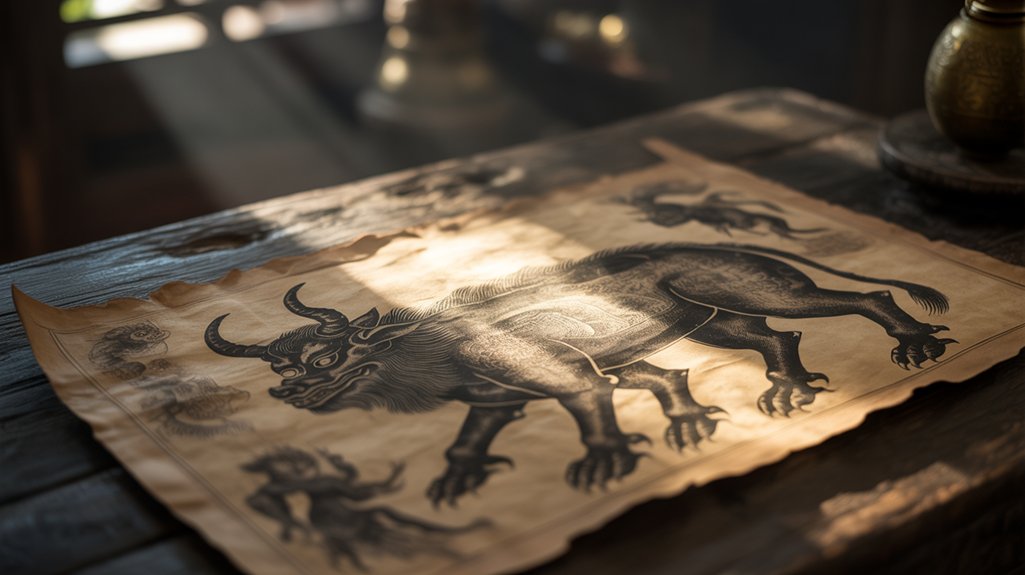
The Bai Ze’s most extraordinary attribute transcends its chimeric form—this celestial creature possesses encyclopedic knowledge of every demon, spirit, and eldritch entity haunting the mortal domain, a vast taxonomy comprising precisely 11,520 supernatural beings.
When the Yellow Emperor Huangdi encountered this divine beast atop Mount Huan during his legendary travels, the Bai Ze imparted its complete catalogue of otherworldly knowledge, including the specific names, behaviors, and protective countermeasures for each malevolent force.
You’ll discover that this encounter, preserved in the *Baize Tu* (白澤圖) or “Bai Ze’s Bestiary,” altered abstract spiritual threats into documented phenomena, offering humanity talismans, invocations, and ritual defenses against the unseen forces lurking in liminal spaces between the living world and the domain of shadows.
Cataloging 11,520 Supernatural Entities
According to legend transmitted through fragmentary Song Dynasty texts, Bai Ze dictated to the Yellow Emperor an extensive taxonomy of every supernatural entity inhabiting the Middle Kingdom—11,520 distinct species of demons, spirits, and eldritch beings that dwelled in mountain caves, river depths, forest shadows, and liminal thresholds between the mortal domain and otherworlds.
This encyclopedic catalogue represented humanity’s first systematic attempt to comprehend the invisible forces shaping existence. Each entry detailed the creature’s morphology, behavioral patterns, seasonal manifestations, and—most significantly—the specific talismans, incantations, or rituals required to ward against malevolent influences or invoke beneficial powers.
Bai Ze symbolism consequently encompasses illumination through knowledge, converting chaos into order. The Bai Ze folklore tradition positions this divine beast as humanity’s protector, offering comprehension where terror once reigned. Understanding became deliverance.
The Emperor’s Consultation
During his eastern journey through the territories bordering the Flowing Sands desert, the Yellow Emperor Huangdi—legendary sovereign and cultural architect of Chinese civilization—encountered Bai Ze atop Mount Huan’s misty summit, where celestial qi concentrated most intensely. The chimeric beast became the emperor’s advisor, sharing eldritch wisdom through ancient predictions spanning generations.
| Knowledge Domain | Entities Cataloged | Protection Method |
|---|---|---|
| Mountain Spirits | 2,340 | Jade talismans |
| Water Demons | 1,890 | Salt barriers |
| Forest Yokai | 3,120 | Sacred fire |
| Urban Haunts | 2,670 | Iron charms |
| Celestial Beings | 1,500 | Ritual purification |
This transmission of supernatural taxonomy enabled humanity’s defense against malevolent forces. Knowledge meant sovereignty over darkness itself.
Protective Talismans and Rituals
When celestial knowledge descended from Mount Huan to mortal hands, it manifested first as the *Baize Tu*—literally “Diagram of Bai Ze”—an illuminated compendium documenting eleven thousand five hundred twenty entities alongside their corresponding apotropaic countermeasures.
You’ll find these protective symbols carved into doorway lintels, embroidered onto silk banners, painted across household thresholds. The chimeric beast’s visage itself became potent warding iconography.
Scholar-priests transcribed ritual practices from the original text: incantations spoken at specific lunar phases, offerings of cinnabar and mugwort, gestures mimicking the creature’s distinctive horns.
These weren’t superstitious remnants but systematized defensive protocols against eldritch incursions. The compilation granted you autonomy—knowledge to safeguard your dwelling without imperial intermediaries.
Direct access to cosmic wisdom. Freedom through preparedness.
Bai Ze in Ancient Chinese Texts and Historical Records
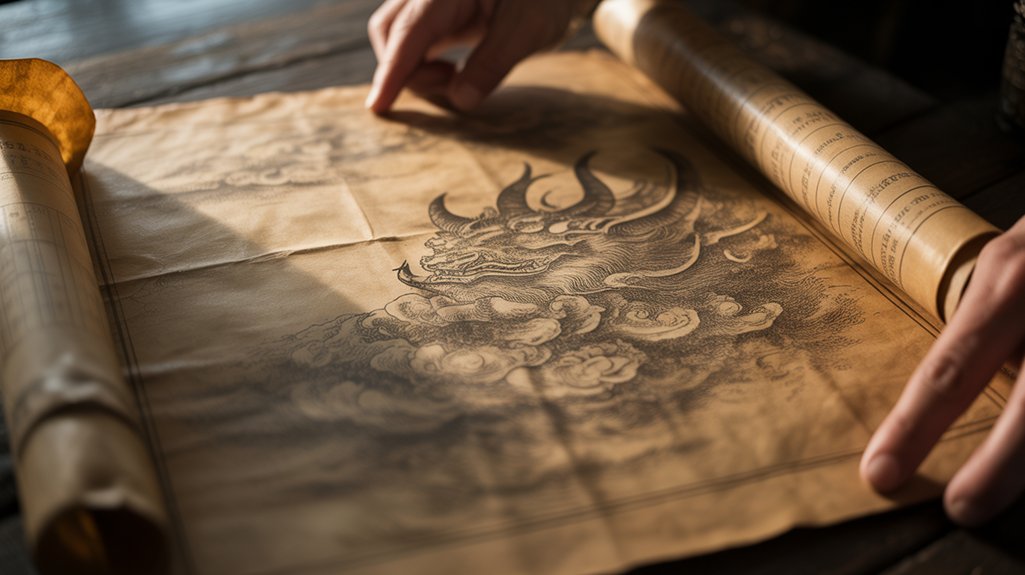
You’ll find Bai Ze’s earliest literary traces in the *Xuanyuan Benji* (軒轅本紀), where the chimeric sage appears before the Yellow Emperor around 2697 BCE, though the text itself dates to the Han Dynasty’s scholarly reconstructions of mythic antiquity.
Imperial archives from the Tang Dynasty onward preserve court memorials documenting Bai Ze illustrations as protective talismans, while Song medical compendiums like the *Bencao Gangmu* catalogue the creature’s supernatural pharmacological properties.
These fragmentary records—spanning divination manuals, bestiaries, and Daoist treatises—position the six-horned beast not as mere folklore but as documented knowledge, a persistent presence threading through China’s textual history like an eldritch constant.
Earliest Literary Mentions
Although Bai Ze’s presence permeates Chinese folklore with an almost numinous authority, the creature’s earliest textual appearances remain frustratingly elusive—fragments scattered across centuries like oracle bones half-buried in loess soil.
You’ll find the literary origins traced to the *Xuanyuan benji* (Annals of the Yellow Emperor), though scholars debate whether this Tang Dynasty compilation preserves genuine pre-Qin material or retrospective mythology.
The earliest depictions emerge during the Han Dynasty, when Bai Ze supposedly encountered Emperor Huangdi on Mount Huan.
There, amid windswept crags, the chimeric beast disclosed knowledge of 11,520 supernatural entities.
These encounters, however eldritch their nature, altered isolated oral traditions into documented wisdom—changing beast into cultural archive, guardian of forbidden taxonomies that would echo through millennia.
Imperial Court Documentation
The beast’s migration from mountain oracle to bureaucratic record marks one of history’s stranger archival journeys.
You’ll find Bai Ze inscribed within Tang Dynasty administrative documents, where its chimeric form served as imperial symbolism—a talisman against chaos threatening the throne.
Court scholars catalogued its eldritch wisdom systematically, converting oral mountain lore into official compendiums.
The beast’s historical significance deepened as emperors commissioned illustrated manuscripts depicting its six horns, each representing dominion over specific supernatural threats.
These weren’t mere decorative additions. They were survival manuals.
Medical and Supernatural Texts
Beyond imperial corridors, Bai Ze’s knowledge infiltrated China’s pharmacological archives and demonological treatises with remarkable precision. You’ll discover this chimeric entity catalogued within medical symbolism frameworks, its six horns representing mastery over afflictions both corporeal and eldritch. Supernatural healing traditions invoked its name against plague-spirits, fever-demons.
| Text Category | Bai Ze’s Function |
|---|---|
| Pharmacopeia | Diagnostic authority over 11,520 supernatural ailments |
| Exorcism Manuals | Protection against spectral maladies |
| Healing Scrolls | Gateway between mortal medicine and otherworldly cure |
The beast’s encyclopedic wisdom offered practitioners freedom from ignorance’s chains. Tang Dynasty physicians (618-907 CE) transcribed its teachings into grimoires, their ink-stained fingers tracing connections between visible symptoms and invisible causes. Knowledge flowed freely. Power resided in understanding.
The Creature’s Role as Guardian Against Evil Forces
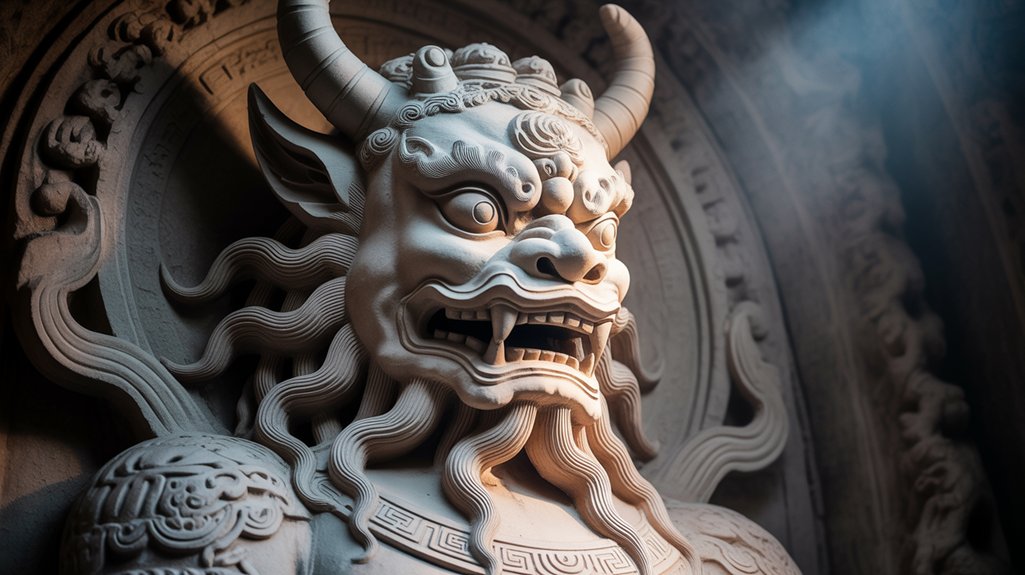
When malevolent spirits prowled China’s borderlands during the early Han Dynasty (206 BCE–220 CE), Bai Ze emerged not merely as knowledgeable sage but as active protector—its six horns serving as supernatural antennae detecting yokai, demons, and pestilence-bearing entities invisible to mortal perception.
You’ll find this chimeric sentinel positioned at thresholds, gates, and mountain passes where the veil between worlds grows thin, its guardian symbolism altering architectural spaces into fortified spiritual boundaries. Temple guardians carved its leonine form into doorways, believing the creature’s presence created impenetrable barriers against eldritch intrusions.
The beast’s evil deterrence operated through recognition rather than violence. By identifying demons’ true names and weaknesses, Bai Ze stripped malevolent forces of their concealing anonymity, exposing them to countermagical rituals.
Ancient texts describe how merely invoking the creature’s image during exorcisms granted practitioners authority over shadowed entities. This wasn’t passive symbolism—it was weaponized knowledge, converting information into protective force that liberated communities from supernatural tyranny.
Artistic Representations Throughout Chinese Dynasties
Across twelve centuries of dynastic change, China’s artists wrestled with an impossible challenge: rendering Bai Ze’s supernatural essence in earthly materials—bronze, jade, ink, and silk—while preserving the creature’s liminal status between documentation and divinity.
You’ll find Tang Dynasty scrolls depicting the beast with meticulous anatomical precision, each horn positioned according to cosmological principles rather than zoological accuracy.
The artistic symbolism evolved dramatically through subsequent eras. Song artisans favored jade talismans, their chimeric subject reduced to elegant abstraction.
Song Dynasty jade carvers distilled Bai Ze’s cosmic complexity into minimalist forms—protection through refined simplicity rather than elaborate detail.
Ming painters returned to elaborate detail, surrounding Bai Ze with the eleven thousand demons it catalogued, creating eldritch bestiaries that served as protective texts.
This dynastic evolution reveals something profound: you’re not viewing mere decoration but apotropaic technology, visual incantations designed to channel the creature’s protective power.
Each brushstroke, each carved line, attempted to trap knowledge itself in form—transforming art into spiritual architecture that still resonates across centuries.
Bai Ze Amulets and Talismans in Traditional Protection Practices
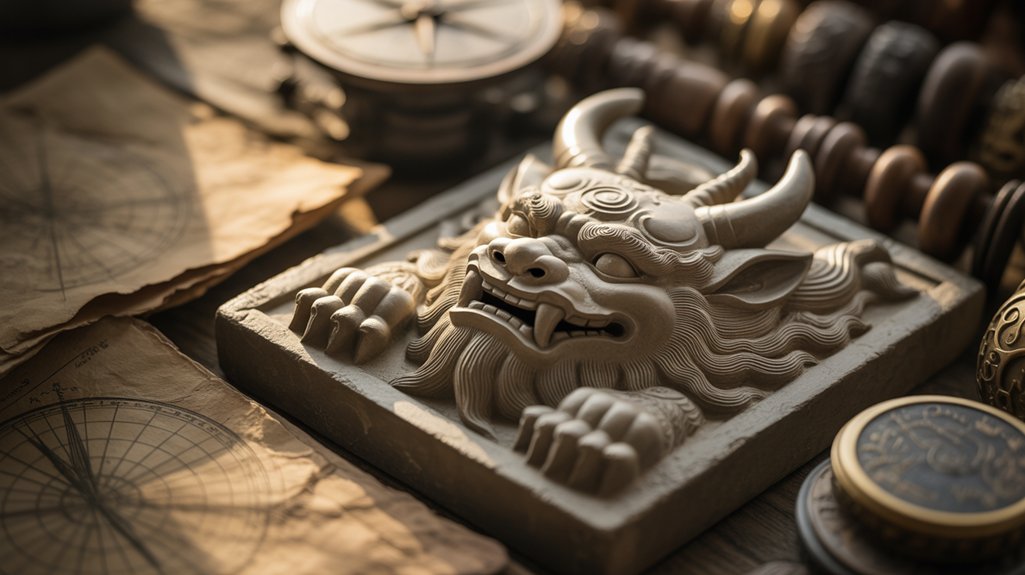
From protective pendants worn against pestilence to ceremonial tablets mounted above doorways, Bai Ze talismans altered the creature’s encyclopedic demon-knowledge into portable apotropaic shields that ordinary citizens could deploy against supernatural threats.
You’ll find these amulets crafted from jade, bronze, and wood—each material channeling different aspects of bai ze symbolism. The chimeric guardian’s image, carved with meticulous attention to its six horns and leonine form, changed household objects into spiritual armaments.
Protective rituals demanded precise placement. Merchants hung Bai Ze scrolls in their shops, believing the beast’s omniscient gaze would detect malevolent entities before they manifested.
Travelers carried miniature effigies, thumb-sized talismans that promised safe passage through eldritch wilderness. During epidemic outbreaks, families commissioned paper versions for burning—converting physical form into smoke that would summon the beast’s protective essence.
These practices weren’t superstition but calculated defensive measures against a cosmos teeming with invisible dangers.
Regional Variations and Cultural Adaptations Across East Asia
The Bai Ze’s migration beyond China’s borders sparked alterations as profound as the creature itself—each culture reshaping the six-horned guardian according to local cosmologies, artistic traditions, and spiritual anxieties.
In Japan, you’ll find the Hakutaku, its chimeric form optimized into elegant woodblock prints, protecting Edo-period households from pestilence with distinctly Buddhist inflections.
Korean interpretations absorbed Confucian hierarchy, positioning Bai Ze symbolism within scholarly discourse rather than folk protection.
Vietnamese regional legends converted the beast into a mountain deity, its eldritch wisdom dispensed through shamanic intermediaries rather than imperial audiences.
These mythological variations weren’t mere copies—they were living translations.
Cultural interpretations reflected each nation’s relationship with knowledge itself: Japanese pragmatism, Korean intellectualism, Vietnamese animism.
The six horns remained, yet their meaning shifted. Protection. Prophecy. Power.
Each culture claimed ownership, adapting the guardian’s essence while preserving its fundamental promise: foreknowledge conquers fear.
The Bai Ze’s Influence on Japanese and Korean Mythology
When Hakutaku scrolls arrived in eighth-century Japan through Buddhist missionary networks, they carried more than pigment and paper—they transmitted a systematic demonology that would fundamentally restructure Japanese protective practices.
You’ll find this Bai Ze influence most strikingly in the *Hakutaku-zu*, talismanic scrolls cataloguing 11,520 eldritch entities, each meticulously illustrated with apotropaic precision. The chimeric beast became Japan’s guardian against pestilence, its image adorning amulets during Heian-period epidemics.
Korean adaptations followed distinct trajectories. The creature—known as *Baektak*—appeared in Joseon medical texts, its prophylactic wisdom embedded within Neo-Confucian frameworks that prioritized cosmic harmony over individual protection.
Where Japanese mythology emphasized the beast’s encyclopedic knowledge, Korean traditions wove it into agricultural calendars, linking its appearances to harvest predictions.
This cultural symbolism reveals divergent anxieties: Japan’s fragmented archipelago craved taxonomic control over supernatural chaos, while Korea’s peninsular stability sought integration rather than categorization.
Same beast. Different worlds.
Modern Revival: Bai Ze in Contemporary Art and Popular Culture
Dormant for centuries in scrolls and stone carvings, the six-horned chimera erupted into contemporary consciousness through manga artist Mizuki Shigeru’s 1960s *yōkai* compendiums, where Hakutaku appeared not as dusty antiquarian curiosity but as breathing mythology demanding recognition.
This Bai Ze revival cascaded across mediums—you’ll find the beast prowling through anime like *Natsume’s Book of Friends*, gracing streetwear designs in Shanghai’s art districts, inspiring tattoos that alter flesh into apotropaic parchment.
Video game developers summon its chimeric form as guardian, quest-giver, eldritch companion. Bai Ze symbolism resonates particularly with youth seeking ancestral moorings in globalized chaos, its promise of protection against ten thousand calamities offering psychic armor.
Ancient armor for digital natives—Bai Ze transforms ancestral wisdom into protection against contemporary chaos, one pixelated guardian at a time.
Contemporary artists render the creature through spray paint, digital illustration, ceramic sculpture, each iteration negotiating between preservation and evolution.
You’re witnessing mythology refusing extinction, adapting while retaining its essential nature: knowledge as shield, wisdom as liberation.
Frequently Asked Questions
How Do You Pronounce “Bai Ze” Correctly in Mandarin Chinese?
You’ll pronounce it “bye dzuh”—the first syllable rhymes with “eye,” while the second carries a soft, buzzing quality.
In Mandarin pronunciation, tonal precision matters: “bái” rises sharply in second tone, “zé” ascends in second tone as well.
This chimeric guardian’s name literally translates to “white marsh,” evoking liminal wetlands where eldritch beings dwell.
Bai Ze significance extends beyond phonetics—you’re invoking an ancient oracle who revealed knowledge of spirits, demons, prophecies.
Are There Any Bai Ze Temples or Shrines Open to Visitors Today?
You’ll find no dedicated Bai Ze temples standing today—this eldritch guardian’s significance lies buried in historical texts rather than sacred architecture.
During China’s dynastic eras, Bai Ze’s history intertwined with imperial collections and scholarly pursuits, not congregational worship.
Temple fragments. Scattered references. The creature’s chimeric form appeared on talismans, scrolls, apotropaic objects guarding households.
If you’re seeking tangible connections, explore museum collections preserving these artifacts—where Bai Ze’s protective essence remains crystallized in material culture, accessible to those who recognize ancient power.
Can I Purchase Authentic Bai Ze Amulets Online or in China?
You’ll find countless bai ze amulets through online shopping platforms like Taobao and Etsy, though bai ze amulet authenticity remains elusive in commercial spaces.
Traditional craftspeople in Shanghai’s Yuyuan Bazaar and Beijing’s Panjiayuan Market offer hand-carved jade talismans, yet distinguishing genuine ritual objects from tourist reproductions requires discernment.
Seek pieces with archival provenance, proper iconographic details—six horns, chimeric form—and materials like nephrite jade or ancient bronze that honor this apotropaic guardian’s millennia-old protective essence.
What Is the Difference Between Bai Ze and the Qilin Creature?
You’ll find Bai Ze origins rooted in knowledge and protection—this chimeric oracle speaks, warns of calamities, catalogues demons.
The Qilin symbolism differs profoundly: it’s a harbinger of righteous rulers, treading so gently it won’t crush grass beneath hooves.
Bai Ze’s eldritch wisdom serves pragmatic defense; you consult it for survival. The Qilin appears unbidden, celestial validation incarnate.
One teaches, catalogues, prepares. The other blesses, confirms, sanctifies.
Both transcend mere bestiality—they’re philosophical principles made flesh.
Did Bai Ze Appear in Any Ancient Chinese Video Games or Novels?
You’ll find Bai Ze legends woven through modern interpretations like threads of golden prophecy—appearing in *Onmyoji* and *Touhou Project*, where the chimeric sage emerges from ancient scrolls into digital domains.
Think of it as revealing forbidden knowledge your ancestors preserved. These contemporary narratives honor Bai Ze symbolism: the keeper of monstrous taxonomies, the eldritch counselor who alters chaos into understanding.
Each pixelated manifestation remains faithful to the original bearer of protective wisdom, freeing forgotten lore.
Conclusion
You might dismiss Bai Ze as mere folklore, yet this chimeric guardian transcends simple superstition. You’ve encountered something profound here—an eldritch catalogue of protection that’s endured millennia. Consider this: ancient texts, modern talismans, cross-cultural veneration. The evidence persists. You needn’t abandon rationality to appreciate how the six-horned beast functions as cultural repository, encoding ancestral wisdom about confronting darkness. Whether metaphor or mystery, Bai Ze remains relevant. Knowledge dispels fear. That truth hasn’t changed.

